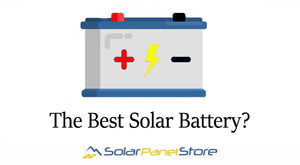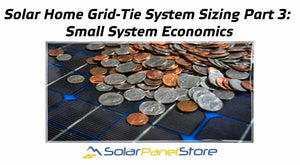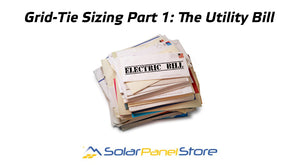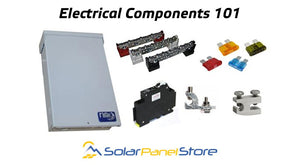Solar Panel Store Blog — Solar Basics

Which type of battery is best for solar applications?
There are several types of batteries that can be used for solar power systems, but the best type of battery will depend on your specific needs and circumstances. Some common options include lead-acid batteries, lithium-ion batteries, and nickel-metal hydride batteries. Each of these types of batteries has its own advantages and disadvantages, so it's important to consider factors such as cost, performance, and maintenance requirements when choosing the right battery for your solar power system.Lead-acid batteries are the most common type of battery used in solar power systems. They are relatively inexpensive and have a long life span, but they can be heavy and can lose their charge quickly if not used regularly. It's common to use sealed or wet style batteries for renewable energy applications.
The main difference between sealed lead-acid batteries and wet lead-acid batteries is the way in which the electrolyte solution is contained. In sealed lead-acid batteries, the electrolyte solution is absorbed into a sponge-like material, whereas in wet lead-acid batteries, the electrolyte solution is held in a separate compartment within the battery.
Sealed lead-acid batteries are also known as "maintenance-free" or "valve-regulated" batteries because they do not require regular maintenance or the addition of electrolyte solution. Wet lead-acid batteries, on the other hand, require regular checking and topping up of the electrolyte solution to ensure that the battery remains in good working order.
Sealed lead-acid batteries are generally more expensive than wet lead-acid batteries, but they are more convenient to use and require less maintenance.
Lithium-ion batteries are becoming increasingly popular for use in solar power systems because they are lightweight, have a high energy density, and can hold their charge for a long time. However, they are also more expensive than lead-acid batteries.
Nickel-metal hydride batteries are similar to lithium-ion batteries in that they are lightweight and have a high energy density. They are also relatively inexpensive, but they may not last as long as lithium-ion batteries.
The team here at SolarPanelStore.com has been working with batteries for off-grid and grid-hybrid systems for many years, and we have a lot of experience that we are happy to share with our customers. Please feel free to contact us for questions about batteries or to help with any kind of solar application!
Solar Home Grid-Tie System Sizing Part 3: Small System Economics
In this example, I'm using the parts list detailed below, which, aside from some site specific wire runs is a fairly complete package for a roof mounted grid-tie system.
6 - Peimar 310W Black Solar Panels
1 - SMA SunnyBoy 3000W Grid Tie Inverter W/SPS
1 - 30 Ft MC4 Solar Panel Cable Extension Wire
1 - Roof Top Junction Box / Combiner Box
1 - SnapNRack Roof Mounting System (4 - 122 Inch Black Rails / 2 - Rail Splice Bars / 10 - Black Mid Clamps / 4 - End Clamps / 4 - Black Rail End Caps / 8 - Black Mounting Feet w/Flashing for Comp Shingle Roof / 8 - Lag Bolts / 1 - Rail Grounding Lug)
This package would come in at 1.86 kW (1,860 W) and cost $3,000 or less depending on some of the specific components.
It's important to make sure that under different conditions an array this small will still work well with the inverter we are using, which is obviously over-sized in comparison to the array. Many inverter manufacturers offer "String Sizing" tools on their website, I also personally like to use the MidNite Classic string sizing tool just for the data it provides to double check with the inverter specs in all different kinds of systems, it's handy as I can get the following results for this particular set-up quickly.
Array Specs:
Number of Panels In Series: 6
Number of Parallel Strings: 1
Total Modules: 6
Rated PV Array Power: 1860 Watts
Anticipated Array Power @ 104 F: 1748 Watts
Rated PV Array Current: 9.51 Amps
VMP (Maximum Power Point Voltage): 195.6 Volts
VOC (Open Circuit Voltage): 244.2 Volts
VMP @ -22 F: 238.8 Volts
VOC @ -22 F: 287.4 Volts
SunnyBoy 3.0 Inverter Specs:
Max. usable DC power: 3100 W
Max. DC voltage: 600 V
Rated MPP voltage range: 155 - 480 V
MPPT operating voltage range: 100 – 550 V
Min. DC voltage / start voltage: 100 V / 125 V
Max. operating input current per MPPT: 10 A Max.
Short circuit current per MPPT: 18 A
For small systems like this, micro-inverters like Enphase Products are also a great choice, and you really don't need to worry about any of these little details as each solar panel uses it's own inverter, so a single panel system could even be taken into consideration.
As a side note, this SPS feature could be used to charge a battery bank for emergency use using a lower cost standard battery charger and low cost inverter, because not everybody really needs the best of the best for a quick black out scenario, and these types of systems can also be fairly cost prohibitive if you're on a tight budget.
Going back to the simple payback methods described in the last blog post, I'll be using PV Watts to calculate the predicted system payback time. Here are the specs I'm using for PV Watts:
System Info:
DC System Size (kW): 1.860
Module Type: Premium
Array Type: Fixed Roof Mount
System Losses (%): 14.08 (Default Loss Calculations)
Tilt (deg): 26.57 (6:12 Roof Pitch, See last blog post for a roof pitch to degrees chart)
Azumuth (Deg): 180
Retail Electricity Rate:
Rate Type: Residential
Rate ($/kWh): 0.11
Annual Average Daily Solar Radiation: 5.72 Hours
Annual Energy Value: $330.00
If we look at the most simple payback method of the original package cost divided by the annual energy value, we come up with 9.09 years to payback. Taking the Federal Residential Renewable Energy Tax Credit of 30% into consideration, that number drops down to 6.36 years. There could and usually are state, local, and utility rebates that Solar Grid-Tie systems would qualify for as well that would drop this even further! Check out the Database of State Incentives for Renewables & Efficiency
Thanks for reading, hopefully this inspires you to check into a system for your home, the sooner it's on the roof the sooner it's going to pay for itself! Our team is always here to help from designs to sale and into the future as a new friend of the solar crew!

Solar Home Grid-Tie System Sizing Part 1: Using a Utility Bill
Step 1: Find your monthly average electricity usage from your electric bill.This will be in kilowatt-hours (kWh). Due to air conditioning, heating and other seasonal usage, it is a good idea to look at several bills. You can add the typical summer, fall, winter and spring bills and divide by four to find the average monthly usage.
Step 2: Find your daily average electricity use. Divide the monthly average number of kWh use by 30 (days).
Step 3: Find your location's average peak sun hours per day. Find what is known as an insolation map, or average sun hour list. For example, Colorado is around 5 peak sun hours. Alternatively, a PV Watts is a great online tool from NREL that will provide great insight for month by month and average solar radiation for your specific location. (https://pvwatts.nrel.gov/)
Step 4: Calculate the system size to provide 100% of your electricity. Divide your daily average electricity use by average sun hours per day. For example, if the daily average electricity usage is 30 kWh, and the site is in Colorado, system size would be: 30 kWh / 5 h = 6 kWh. It's a good idea to multiply this number by 1.15 in order to account for factors such as inverter efficiency, dirt or pollutants that may accumulate on panels, etc., if you want to cover all of your use. (One of our solar home packages in the 7 kW range would be great for this!)
Take a look at some of our system options for grid-tie packages here, or contact our sales team for more information, we are eager to help out and provide you with everything you need to go solar!
- Loren Geist
- Tags: grid tie solar Learning Solar Solar Basics Solar Panels solar size

Electrical Components 101
Want a brief summary of some of the common electrical components used in a solar system? Whether you're interest is grid-tied solar or off-grid solar, you'll get a taste of fuses, disconnects, wire and more.- Thomas Lindberg
- Tags: Breakers Electrical Fuses Solar Basics Wire




